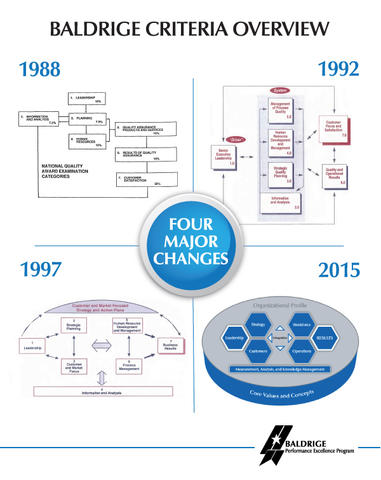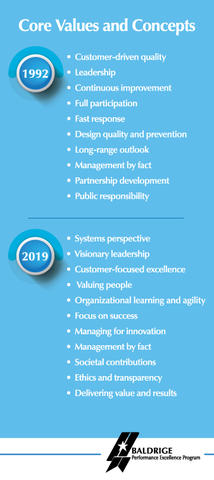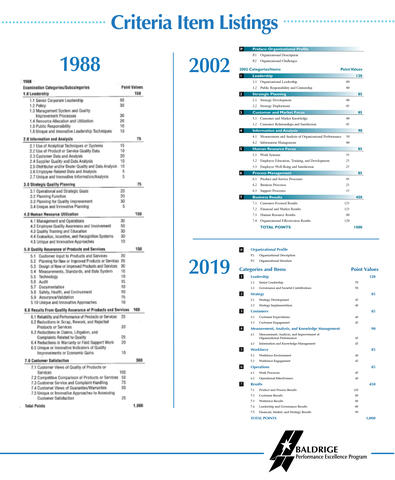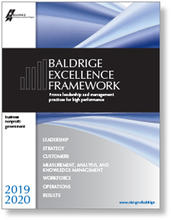Blogrige
The Official Baldrige Blog

Summer 2019
From Product Quality Assurance to Organizational Performance Excellence
For 30 years, the Baldrige Performance Excellence Program (BPEP; originally known as the Malcolm Baldrige National Quality Award Program) has defined what constitutes a high- performing, role-model organization. The change in name alone demonstrates the profound changes in the program (part of the National Institute of Standards and Technology) over 30 years. Originally seen as an award program offering criteria for identifying role-model for-profit companies for the United States, BPEP has evolved into a program that helps organizations in all sectors of the economy to improve and innovate, to get them to levels of performance they have not seen before and, often, which they never imagined they could reach.
The program has moved from being an award program with an education component to an education program with an award component. The program’s key product has evolved from a single set of business award criteria to a suite of performance improvement tools that all organizations can use. The program has evolved from a single national award program to a program that has been copied and emulated around the globe and in local, regional, and industry-specific “Baby Baldrige’s,” a term originated by Business Week magazine. The Presidential award, created specifically for businesses, has evolved, like the overall program, to include applicant categories for education and health care organizations and, subsequently, for nonprofit organizations of all kinds, from charitable to trade to governmental. And pilot efforts now underway have expanded the Baldrige concepts to communities striving to improve life for their citizens.
There are many possible approaches to documenting how the Baldrige Program has evolved, starting with the title of its premier publication, from Baldrige Award Application Guidelines in 1998 to the Baldrige Excellence Framework today. Our definition of performance excellence was originally “to deliver ever-improving value to customers, while improving the overall effectiveness and efficiency of the organization.” While still true to this concept today, we have learned that excellence is more complex. Today we define performance excellence as “an integrated approach to organizational performance excellence that results in (1) delivery of ever-improving value to customers and stakeholder, contributing to ongoing organizational success; (2) improvement of your organization’s overall effectiveness and capabilities; and (3) learning for the organization and for people in the workforce.” We recognize today that excellence is not just about how you approach your work; excellent approaches must deliver positive results. Value must be delivered to all your key stakeholders, including your community, not mainly stockholders/owners/donors. This is a concept long practiced by Baldrige framework users and recently acknowledged by the Business Roundtable. To sustain high performance, an organization must look beyond effective current operations; it must continuously enhance its capabilities and learn as an organization and provide learning opportunities for its workforce.
I have chosen to highlight the Baldrige “revolution” through four evolutionary lenses: the Baldrige Excellence Framework diagram, the Baldrige Core Values and Concepts, the Baldrige Criteria (for Performance Excellence), and the creation of other Baldrige educational and self-assessment documents and opportunities. Since I can’t resist the temptation, I will conclude with some thoughts on trends that might impact the Criteria over the next ten years.
The Baldrige Framework Diagram
There have been four major iterations of the framework diagram.
 Credit:
Andrew Krasovitckii/Shutterstock
Credit:
Andrew Krasovitckii/Shutterstock

Perhaps the most profound change in the Baldrige Program occurred at the time of the transition from the second framework diagram to the third. That was the time when the focus on overall organizational performance excellence and a systems approach to that overall performance took hold. That basic framework diagram change was made in 1997, ten years after the start of the Baldrige Program. It was actually slightly modified again in 2001, with the umbrella over the diagram changing to the Organizational Profile, indicating the clear role the Profile plays as an overarching context for the organization’s performance management system. In 1997, Results also became a separate Baldrige Criteria category, emphasizing (with 450 out of 1,000 points of the evaluation scoring system) that having a process without achieving commensurate results was meaningless.
The current framework diagram has three significant changes: (1) the Organizational Profile is now shown as the background “color” for the whole framework, indicating the pervasive nature of your operating environment, relationships, and strategic situation as influencing everything you do as an organization; (2) the word integration is now part of the framework, indicating the holistic, and interrelated nature of the Baldrige Criteria categories and questions; and (3) the Core Values and Concepts are now part of the framework, indicating their foundational nature in a performance management system as values embedded in high-performing organizations.
Core Values and Concepts
While the Core Values and Concepts were not articulated in the first Baldrige Criteria in 1988, they were as much a part of those criteria as they were in 1992, when the core values were specified for the first time. Those initial core values and concepts and the 2019 version are shown below.

The Criteria for Performance Excellence
Originally a set of statements, the Baldrige Criteria became a set of questions in 1999, recognizing that leaders guided an organization’s performance management and that the criteria questions should guide you by asking how you accomplish your mission, how you plan for the future, and what your results are.
The evolution of the criteria has always been driven by the mantra that the criteria reflect the leading edge of validated leadership and performance practice.
A listing of criteria item titles from 1988, 2002, and 2019 is shown below.

The following observations are apparent when you consider these titles and what they mean to your organization.
- The number of items has been reduced from 42 to 17 (plus two for the Organizational Profile). This reflects a better understanding of critical components of an organizational performance management system. The change also demonstrates the evolution of the Baldrige Criteria as a resource for quality assurance to process quality to overall organizational performance management.
- The Organizational Profile, not in the 1988 criteria, now serves as “category 0” of the criteria, with the purpose of setting the organizational context that provides the basis for your answers to all the remaining questions in the criteria. For many organizations, addressing the questions in this profile serves as a first Baldrige self-assessment, in which organizations learn and define all aspects of their operating environment.
- The early focus on data analysis and information generation has evolved to a focus on measurement, analysis, and improvement of all aspects of organizational performance. Management of information and information systems, and the management, sharing, and building of organizational knowledge are now vital components of organizational strength and differentiation.
- The focus on strategic quality planning has been replaced by a focus on organizational strategic planning as the criteria have evolved from a focus on product and process quality to a focus on overall organizational excellence.
- Human resource utilization, with a component of employee quality training, has evolved to a workforce focus, with recognition that the people in the organization are valued as internal customers who deliver the products and services that engage the end customer. This focus must consider all aspects of the workforce environment and workforce engagement, particularly development of a healthy organizational culture, career development for employees, and appropriate recognition systems.
- A focus on product and process quality and auditing of suppliers has evolved to a focus on all key work processes and overall operational effectiveness, including process effectiveness and efficiency, security and cybersecurity, safety, and emergency preparedness.
- The initial emphasis on individual quality improvement activities has evolved to consider cycles of evaluation and improvement and, currently, the overall organizational performance improvement system and innovation.
- The early focus on customer satisfaction has evolved to focus on customer expectations, customer engagement, and customer loyalty, including a strategic focus on market environments.
- Scoring in the 1988 criteria was largely driven by an organization’s process improvement. By 2002, a clear focus on all aspects of organizational performance results was articulated by the addition of the Business Results category, with 450 points allocated for this category out of the total of 1,000 points in the Baldrige Scoring System. More recently, including in 2019, the Results category has an added emphasis on leadership, governance, and strategy results.
I think it is also interesting to look at some key dates in the evolution of the criteria to show the changing nature and evolution of organizational performance excellence.
1995
Strategic quality planning was replaced by strategic planning. This was the point where we realized that the quality planning function had to be for the whole organization—not just product/service delivery and customer processes—that organizations could not plan for quality independent of overall strategy. This was the start of a larger reframing of the criteria to focus on overall organizational performance.
2001
The Organizational Profile was added to the criteria. As stated above, it transformed generic criteria questions into an organization-specific framework.
2003
This was a major criteria transition year. The criteria were revised with the dual purpose of “running the business” and “changing the business” as guidance. Linkages among categories were enhanced with the goal of evidence-based management as a guide. Organizational knowledge management was added, recognizing that this had become a significant source of competitive advantage. Governance and social responsibility were added to the Results category.
2004
The Scoring System for evaluating process item responses (categories 1 through 6) was reengineered to reflect process maturity along four dimensions: Approach, Deployment, Learning, and Integration (ADLI). One way of viewing these four dimensions is as an organizational approach to Plan-Do-Check-Act (PDCA). The integration dimension was particularly important as it links processes with what is important to the organization from other Baldrige Criteria items, the Organizational Profile, and key results.
2005
To set the context for strategic planning, the identification of the organization’s strategic challenges was added to the Organizational Profile. The Leadership category was expanded to address leaders’ role in ethical stewardship of the organization and in developing future leaders. To complement these leadership questions, leadership effectiveness results were added to the Results category.
2007
To round out the strategic context in the Organizational Profile, questions were added about the organization’s strategic advantages and strategic opportunities (ideas for new products, services, markets, strategic partnerships, etc.). Several new concepts critical to high performance were also introduced. Workforce capability and capacity questions were added to ask about having the right knowledge and skills available and the right number of people available, respectively. Work systems, work processes, and core competencies address how the work of the organization is accomplished, including what work is outsourced (work systems), the work accomplished with the organization’s workforce (work processes), and the organizational skills/capabilities that are critical to accomplishing the work of the organization (core competencies).
2008
The Scoring System for evaluating results item responses (category 7) was reengineered to reflect performance maturity along four dimensions: Levels (current performance), Trends (performance history), Comparisons (relative performance to competitors and best performers), Integration (are you measuring what is important based on your Organizational Profile, key processes, and customer requirements?). The acronym for these dimensions is LeTCI (as in “let’s see” how you are doing).
2009
Several new concepts were introduced in the 2009 criteria. The first was a shift from customer satisfaction to customer engagement, a focus that included satisfaction, dissatisfaction, and relationship building to develop customer loyalty. With the expanding use of electronic information and issues of access becoming significant, a new item in the criteria dealt with management of information technology and systems. Finally, recognizing the value to key stakeholders of an organization’s “triple bottom line,” societal responsibility was incorporated as a cross-cutting consideration.
2011
This was the year that innovation went from being a component of strategic planning to a cross-cutting consideration for leadership, strategy, and the organization as a whole. The concept of intelligent risks was introduced to prioritize strategic opportunities that will be pursued based on their importance to an organization’s future success and, maybe, survival. And the criteria now recognized that senior leaders are expected to provide a supportive environment for intelligent risk taking. 2011 was also the year that the use of social media, though not yet widespread in business, was of sufficient significance that it was introduced in the criteria content.
2015
The growing use of big data and data analytics was a focus of change in the 2015 criteria. Organizational change management was also embedded in the criteria, with dual foci on the design of change and its tactical implementation.
2017
In a rapidly evolving world, the CEO suite in all organizations is increasingly challenged. In 2017, these challenges led to an enhanced focus in the criteria questions on cybersecurity and enterprise risk management (bringing together some of the concepts introduced in the past several criteria editions).
2019
In the 2019 criteria, the Baldrige Program has started introducing the increasingly significant strategic consideration of business ecosystems: cross-industry, domestic, and global systems of partnership to enhance opportunities and organizational effectiveness. As with other considerations, such as social media in 2011, the initial introduction is largely about awareness building, recognizing that we anticipate growing importance of this concept to organizations in the future.
Additional Educational and Self-Assessment Information
In 1988, the Baldrige Program produced the first set of award application instructions, including the criteria for evaluating a business. Since then, there has been great growth in resources available from the program. These include Baldrige Award recipient descriptions and application summaries, case studies and related resources, fact sheets, Baldrige examiner training materials, and blogs (via Blogrige).
Beyond submitting an award application, opportunities for organizations now include participating in a collaborative assessment process, having employees attend the Baldrige examiner training experience (without being a Baldrige examiner), attending Baldrige educational conferences, and having organizational executives participate in the Baldrige Executive Fellows Program.
In 1998, the first official sector-specific sets of criteria for health care and education organizations were introduced. Earlier pilot criteria had been released in 1994. In 2002, the first Baldrige Criteria-based perceptional survey tool Are We Making Progress? was introduced. That was followed in 2004 by a companion document for use by leaders, Are We Making Progress as Leaders? These documents provide a quick snapshot of organizational strengths and opportunities for improvement from the perspective of employees and senior leaders.
In 2015, the Baldrige Excellence Builder was introduced. This abbreviated version of the Baldrige Excellence Framework provides a self-assessment tool for organizations that are getting started with the Baldrige Criteria. It ties directly to the more extensive set of criteria in the Baldrige Excellence Framework, by asking the overall (high-level) questions from the larger set of criteria.
In 2017, the Baldrige Cybersecurity Excellence Builder was introduced. This self-assessment tool, similar to the Baldrige Excellence Builder, asks key questions for improving your organization’s cybersecurity performance.
In 2019, a Baldrige Core Values-based tool for assessing role-model attributes of your organization’s leaders was added to the Baldrige Program’s website. Later this year, a companion tool for boards of directors will be available.
The Next Ten Years

Not hampered by current organizational design or challenges, it is fun to speculate about some of the drivers of organizational performance and strategy that will affect the Baldrige Excellence Framework and the Baldrige Program a decade from now.
Let me start by stating the obvious: With advances in technology continuing at the current or an accelerated pace, it is impossible to predict the specifics of technology’s impact on the way we will look at organizations, what they will offer their customers, and how they will operate.
Some things appear certain based on current trends. Cybersecurity, data analytics, and artificial intelligence will continue to be of growing importance to organizations’ strategy, how they function, and the skill sets employees will need.
Technology will drive changes in the jobs that people have, with the balance between work accomplished by robots and “thinking” computers and work accomplished by people shifting significantly. It may mean that full-time employment by one employer will be significantly replaced by workers who are independent contractors with multiple employers that vary over time. It will impact how health insurance is purchased and how retirement is financed during people’s working years.
I believe the human workforce will be driven toward jobs that involve emotional, interpersonal, and intuition-based decision making. Jobs that are conceptual in nature, such as scientific and social science research, will still require humans to succeed.
Many people are likely to have more free time, which will mean more people engaged in travel and leisure professions. It also means that people will have greater time for doing social good and seeing to societal responsibility. This should lead to greater pressure on businesses and municipalities to provide resources for these endeavors and to look at opportunities to provide products and services that improve societal well-being and enhance brand image, as well as generating enhanced revenue.
Ecosystems will take on larger scope, moving from business ecosystems to societal ecosystems, bringing businesses, nonprofit organizations, and local government together in new and novel partnerships. Much of health care and education will be delivered remotely and online, requiring new payment models and more “on-call” professionals.
I believe all these changes will take place in a much less certain economic and political climates around the globe and nationally. SWOT (Strengths, Weaknesses, Opportunities, and Threats) analysis and PEST (external Political, Economic, Social, and Technological factors) analysis will become two legs of the strategic planning stool. The third leg will be risk management and innovation. And ongoing innovation will involve more than looking for opportunities. It will become an organizational necessity.
A bottom line of all the above changes will be a universal use of some form of scenario planning when it comes to strategic planning. All organizations (and quite possibly, families, as well) will have to envision multiple futures dictated by external and internal forces and have planning scenarios for each.
I’ll check back in a decade to see how I did—or maybe sooner, if the pace of change continues to accelerate!
Infographic

Resources
Culture and Strategy Eat All Three Meals—When Leaders Set the Menu (Spring 2019)
Is Good, Good Enough for You? Taking the Next Step After ISO 9001:2015 (Winter 2018-2019)
Archived Columns

Baldrige Excellence Framework
The Baldrige Excellence Framework has empowered organizations to accomplish their missions, improve results, and become more competitive. It includes the Criteria for Performance Excellence, core values and concepts, and guidelines for evaluating your processes and results.
Purchase your copy today!
Available versions: Business/Nonprofit, Education, and Health Care
About the author
Related Posts
Comments
reply on behalf of Harry Hertz
Thanks Steffani.
Thank you, Harry. EXCELLENT, EXCELLENT article.
We'll use it in the graduate engineering class Gary Floss and I teach [our 21st year] at the University of St. Thomas in St. Paul. STRATEGIC QUALITY MANAGEMENT.
reply on behalf of Harry Hertz
John, thanks for the comment. You have given me an idea as well. I will use the blog in the graduate course I teach on Strategy and Organizational Analysis to help the students understand the changing organizational landscape and the increasing complexity and challenges of leading an enterprise.
HH, thanks for compiling this chronology of changes in all the key elements of the program. The photo showing you looking in the rearview mirror and through the windshield to the road ahead now has new significance to me. I came into the program at Stege 2. This article helped me reflect on how the changes I experienced serially over the last 22 years were a ... wait for it ... wait for it ... wait for it ... holistic experience. Thank you, sir.
reply on behalf of Harry Hertz
Barry, it is amazing to revisit the changes we have witnessed. And wait..wait, the changes have been holistic, engendering integration and a systems perspective!






This is fantastic! Thank you, Harry.